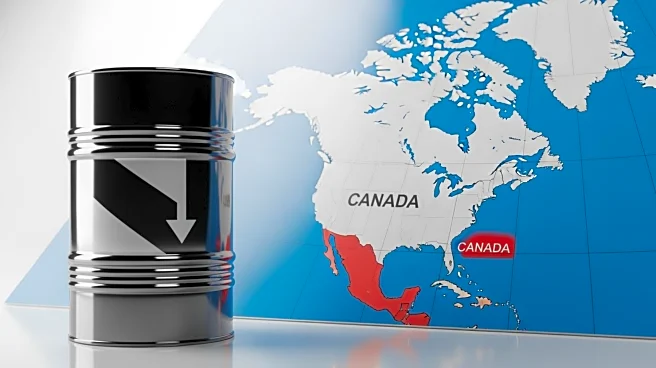What's Happening?
The Canadian dollar fell slightly against the U.S. dollar as investors evaluated the prospects of a sectoral trade deal between the U.S. and Canada. The loonie traded 0.1% lower, influenced by falling
oil prices and ongoing trade negotiations in sectors like steel, aluminum, and autos. The United States-Mexico-Canada trade agreement is set for review in 2026, adding pressure to current discussions. The price of oil, a major Canadian export, dropped by 0.7%, affected by U.S.-China trade tensions and forecasts of a supply surplus. Domestic data showed declines in wholesale trade and manufacturing sales, contributing to economic concerns.
Why It's Important?
The dip in the Canadian dollar reflects broader economic challenges, including trade tensions and fluctuating oil prices. As Canada negotiates with the U.S. on key sectors, the outcome could significantly impact Canadian industries and economic growth. The potential for interest rate cuts by the Bank of Canada, amid economic data showing declines, could further influence the currency's value and investor confidence. The interconnectedness of trade agreements and economic indicators underscores the complexity of international economic relations.
What's Next?
The Bank of Canada is expected to address the economic outlook, with potential interest rate adjustments on the horizon. Investors will be watching for developments in trade negotiations, as these could shape future economic policies and market conditions. The review of the United States-Mexico-Canada trade agreement in 2026 will be a critical juncture for assessing the long-term impact of current negotiations. Stakeholders in affected industries will need to prepare for possible changes in trade dynamics and regulatory environments.
Beyond the Headlines
The ongoing trade negotiations highlight the importance of international cooperation in addressing economic challenges. The potential for a sectoral trade deal could set a precedent for future agreements, influencing global trade policies. The decline in oil prices and its impact on the Canadian economy underscores the need for diversification and innovation in energy sectors, as reliance on traditional exports may pose risks in volatile markets.












